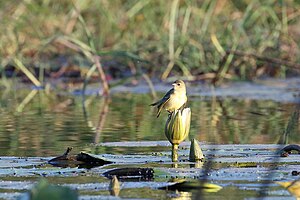Katanga weaver
| Katanga weaver | ||||||||||||
|---|---|---|---|---|---|---|---|---|---|---|---|---|

Katanga weaver ( Ploceus katangae ) |
||||||||||||
| Systematics | ||||||||||||
|
||||||||||||
| Scientific name | ||||||||||||
| Ploceus katangae | ||||||||||||
| ( Verheyen , 1947) |
The Katanga weaver ( Ploceus katangae , Syn. Loxia katangae ) belongs to the family of the weaver birds (Ploceidae) to the genus of the bunting weaver ( Ploceus ).
This bird was previously regarded as a subspecies (Ssp.) Of the mask weaver ( Ploceus velatus ), or the Ruwet weaver ( Ploceus ruweti ), the Reichard weaver ( Ploceus reichardi ) or the yolk weaver ( Ploceus vitellinus ).
The Latin additional species refers to the province of Katanga .
The bird is found in the southeast of the Democratic Republic of the Congo and in northern Zambia .
The distribution area includes moist habitats , preferably along rivers with high reeds or papyrus cover.
features
The species is 13 cm tall, making it a small weaver bird, also smaller than the similar masked weaver. The male has black on the forehead, reins, cheeks, ear covers , chin and throat with a narrow extension on the chest in the brood plumage . The parting is saffron yellow, the nape is golden yellow like the underside. The rump is greenish-yellow. Females and juveniles have paler plumage.
Geographic variation
The International Ornithological Union and Avibase recognize the following subspecies:
- P. k. upembae ( Verheyen , 1953) - southeast of the Democratic Republic of the Congo
- P. k. katangae ( Verheyen , 1947), nominate form - extreme southeast of the Democratic Republic of the Congo and northern Zambia
The former is listed in the Handbook of the Birds of the World as an independent species of Upenba weaver ( Ploceus upembae ), and the Katanga weaver ( Ploceus katangae ) is therefore regarded as monotypical .
voice
The male's singing is described as an extended chatter, the contact call as "chuk".
Way of life
The diet is unknown.
The breeding season is between January and March in the Congo and between September and October and March in Zambia.
Katanga weavers are probably polygynous , breeding in small colonies , but also individually.
Hazardous situation
The stock is not considered to be at risk ( least concern ).
literature
- R. Verheyen: Sitagra velata katangae. In: Mémoires du Musée royal d'histoire naturelle de Belgique . Vol. 23, No. 10, 1947, p. 4
Web links
- Videos, photos and sound recordings of Ploceus katangae in the Internet Bird Collection
- Weaver Watch